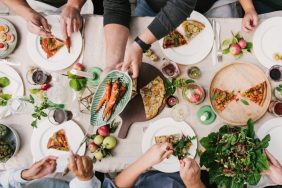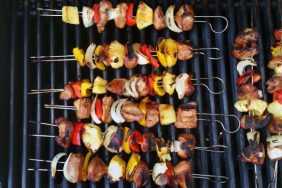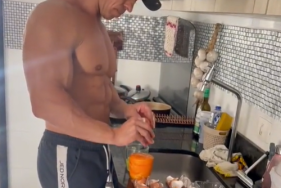Above: Spaghetti squash tacos.

If the thought of Meatless Monday makes you want to binge-eat a rack of ribs, you’re not alone. But the fact is: most Americans eat too much meat. While poultry, pork, and beef are efficient sources of protein, they’re not the only ones. Cooking Channel host and author Nikki Dinki advocates reducing–not eliminating– meat and making vegetables the main part of your meal. How do you go about that? She’ll show you in her new Meat on the Side cookbook, in which she recreates carnivores’ favorite eats with vegetables. Eggplant meatballs, cabbage nachos, and zucchini crust pizza are just a few of the 100 fake-out recipes in the book.
We spoke with Dinki to better understand the advantages and benefits of rethinking meat as the centerpiece of the dinner plate.
Crave: Why should we eat less meat?
Nikki Dinki: It’s really what everyone, up to the government, recommends. We only need about 5 to 6 ounces of meat per day, per person. That’s really our limit and that’s what a lot of people are consuming in one meal and they’re having meat at every meal. It’s about rethinking your plate and eating the way your body wants you to eat, which is less than 5 ounces of meat a day. All my recipes put extra vegetables in all of your meals so you are getting extra nutrition and I’m hopefully making the meals tastier with those veggies. At the end of the day, you have a more balanced plate, you’re getting more of what you need, you’re going to have 30 to 40 percent less calories because you’re eating a different ratio of meat to veggies than what you’re used to.
Also: Make Your Favorite Foods Healthier With “The Dude Diet”
[Eating meat] is really hard on our environment and on our pocketbooks. Meat is what we spend most of our money on. This is not a diet. It’s thinking about our plate a little bit differently and focusing on those veggies more than the meat. It’s a simple thing that can suddenly make you lose weight and save money. It has this great trickle-down effect.
Many of our readers are young males and they might be concerned with maintaining a certain musculature. How do they get enough protein from sources other than meat?
I think we sometimes forget there are other ways to get protein besides animal meat. There are so many veggies and grains that have tons of protein in them. I tend to make my meals almost like I’m making them for a vegetarian, and then I add meat in. Even if you take the meat out of them, you’re still going to have a really balanced meal that has plenty of protein.
In general, we’re probably eating more protein than we need. I think that as far as maintaining muscle, there’s plenty of protein in my recipes and actually having them come from different sources can make them be absorbed better and be even better for you and your physique.

Above: Tomato bun burger.
There’s a common misconception that vegetables take a lot of time to prepare. What are some of the vegetables that are easier and quicker to incorporate into meals?
The ones that are the most difficult to prepare are a lot of the ones that I end up buying pre-cut from the grocery store. I haven’t cut up a butternut squash in a little bit because my grocery store does that for me and has it ready in the produce section. Corn and peas are two great ones that you will almost always find in your freezer section. They’re picked at the very ripest they can be and then they’re frozen. A lot of times, frozen peas, frozen corn, even frozen broccoli, you’ll find them better frozen than fresh, as long as you’re not super concerned about the end texture.
Many of my recipes I call “10 in 20” or “10 in 30” so they’re ten ingredients done in 20 minutes or ten ingredients done in 30 minutes so this is how we prove veggies can be made very quickly. I was just glancing at the roasted broccoli, corn, and green chile stuffed naan. It’s like a stuffed pita. In that equation, the green chiles come from a can, the corn comes fresh or frozen or even out of a can, and the broccoli I cut it so small so it cooks in 5 minutes. It’s thinking about it a little bit smarter. There’s also a lot of veggies that I use raw, like a pepper. I tend to not always sauté that. Or even zucchini. Those are things that I will use in raw preparation. You don’t have to cook them at all.
Fat plays a role in satiation. How do you use fat in your meals to make them filling?
I definitely have some fat in my meals. There was one negative review that I had on Amazon because I used whole milks and yogurts and cheeses and some butter. And I do use those things. I use them very smartly. I’m not going to put cheese in something if you’re not going to barely notice that it’s there. I tend to put the cheese on top of the item, so I’ll use a stronger cheese. If I do use butter, I take 3 minutes to brown it so it’s nuttier and more impactful. So there’s definitely fat in here. Fat, we’re learning more and more, is really essential to absorbing nutrients that we get from those veggies.

Above: Eggplant meatball hero.
You weren’t always a big vegetable eater. What turned you around?
I didn’t eat a single vegetable until I was 20. It took a long time. The lesson that I learned was: you can eat something and over time, go from hating it to loving it. I just didn’t realize that as an adult, I could learn to like something. I simply thought, “If I don’t like carrots, if I don’t like broccoli, I just don’t like them.” And that’s really not true. You just haven’t eaten them enough times. There are definitely some foods that people like more than others; naturally some things agree with us more. But you can learn to love anything if you eat it enough. I learned that I could eat that tomato, that zucchini. One of the last vegetables that I learned to love was a cucumber. It seems so silly now.
Once I realized that you could learn to love things, and learn to expand your tolerance, it’s very empowering. I felt like this world of food was opening up to me. Knowing that I could try something and eventually love it and learn to eat as many foods as I wanted really changed things. I wasn’t feeling my best at that time in my life and I knew that my nutrition had to change. I didn’t want to change. I didn’t like anything that was good to me, so learning that I could learn to like those things was really fun and important for me.
You’re the host of the Cooking Channel’s “Junk Food Flip” show. What are one or two of your favorite flips?
One of the things that I’ve been doing recently that’s unique are chickpea breadcrumbs. I take a can of chickpeas and I put them in the oven until they dry out, then I pop them in the food processor with some Italian seasonings, and I make this really fun chickpea breadcrumb. It’s a crunchy topping that I would use any other way that I would use breadcrumbs, but obviously it’s a bean, so it’s got way more nutrition than white bread. It’s a way that you would never think to eat beans or a vegetable: as a breadcrumb on something. You think you’re just adding it for texture, but you’re adding it for nutrition also.
The other thing I’ve been on a kick with is taking cashews and soaking them in water until they’re really tender, and then pureeing that into my soups or into sauces as a substitute for heavy cream or cream cheese. When I tray it up, it goes from a thin veggie soup to something really creamy and indulgent.








